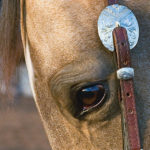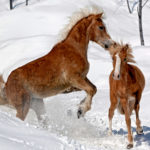Q: The Truth about Wiggling Your Fingers
Is wiggling your fingers a quick fix or is it a correct technique to get your horse on the bit?
Nancy Booker
San Juan, California
A: John Zopatti
Wiggling your fingers is neither a quick fix nor a correct technique to get your horse on the bit. The only part of the horse that wiggling your fingers affects is his jaw. While you might feel that you gain control by wiggling the bit, the only thing you control is the horse’s head, neck and flexion, leaving the rest of the body uninfluenced. This can be described as front-to-back riding. This activity creates a false frame by arching the neck without a connection to the hindquarters. If you are wiggling a horse on the bit, you can probably pilot him around a 20-meter circle, but movements such as leg-yield, shoulder-in or lengthenings will be near impossible. Let’s discuss why.
Contact in the reins should be in direct relation to the activity of the hind leg. It’s important to keep contact on both reins and use a connecting half halt. That means that you’re going to close your leg and add the power from behind so that when you receive your horse in your hand, you’re not wiggling around but recycling the power of the hind legs and engaging him, instead of wiggling his head. Remember, wiggling throws the engagement away because contact in the rein is no longer steady enough to be in direct relation to the hind leg.
The goal in dressage training is to increase the engagement of the hind legs. This engagement allows us to keep the rein steady and produce a balanced outline with the elastic contact we want for the level of each horse. Without steady contact, the horse will not be able to produce a steady rhythm, relaxation or connection, which together make the base of the Training Scale. Wiggling your fingers interrupts the rhythm, makes the horse think only about his front end and breaks the connection to his hind legs. Since leg-yield, shoulder-in or lengthenings require varying amounts of engagement of the hind legs, this is possible only with a steady connection in the reins. Therefore, wiggling the bit is counterproductive to throughness.
So why is there so much wiggling of the fingers anyway? It’s actually human nature. Humans tend to do most of their daily activities by feeling with their hands. Wiggling gives the rider a feel in his or her hands, albeit an incorrect feel. It is much easier to be busy with our hands (wiggle) than to be busy with our legs and seat. The challenge is training the body to feel a soft, steady connection (to the hind leg) in the hands while developing increased sensitivity and feel in the seat and legs. Ironically, while wiggling the fingers can make the rider feel more in control, it tends to make the horse lose confidence. This is because horses seek steadiness. I have yet to see a horse running around his paddock, wiggling his own head into position. Conversely, I have seen many a horse freely galloping around a paddock, powering up his own hindquarters, producing the most beautiful arched, steady topline. I think it is far more productive to ride horses following their natural tendencies, than to try to wiggle them into our human nature!
John Zopatti is a USDF gold medalist and an “L” Education Program graduate with distinction. He’s also a four-time Gold Coast Dressage Association Trainer of the Year. He spends his summers in Pinehurst, North Carolina, helping several successful eventers gain an edge in dressage.





